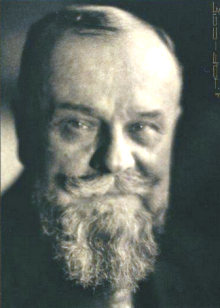Charles Plumet
| Charles Plumet | |
|---|---|

Charles Plumet in 1925 by Laure Albin Guillot
|
|
| Born |
17 May 1861 Cirey-sur-Vezouze, Meurthe-et-Moselle, France |
| Died | 15 May 1928 (aged 66) Paris, France |
| Nationality | French |
| Occupation | Architect, decorator, ceramist |
| Known for | Art Nouveau |
Charles Plumet (17 May 1861 – 15 April 1928) was a French architect, decorator and ceramist.
Charles Plumet was born in 1861. He became an architect and designed buildings in medieval and early French Renaissance styles. He collaborated with Tony Selmersheim (1871–1971) on interiors and furniture design in Art Nouveau forms. Charles Plumet became a member of l’Art dans Tout (Art in Everything), an association of architects, painters and sculptors that was actively trying to renew decorative art between 1896 and 1901, following styles from adapted medieval to Art Nouveau. Other members were Tony Selmersheim, Henri Sauvage, Henri Nocq, Alexandre Charpentier, Félix Aubert, Jean Dampt and then Étienne Moreau-Nélaton.
Plumet was committed to functionalism and against the academic approach of the École des Beaux-Arts. In 1902 he expressed the principle that "forms derive from needs". In 1907 he published two articles on regional architecture in L'Art et les artistes in which he said architecture should be united with the landscape. He wrote an article that praised Louis Bonnier (1856-1946), who he thought had carefully adapted forms to contexts and needs, but he rejected architecture that imitated the landscape. He said architecture should "develop in its setting like a flower or plant." However, he gave the functionalist view that designers should add elements such as balconies, terraces, porches or gables "as context suggested" to express "the dweller's needs with regard to the climate, the orientation and the view."
By the start of the 20th century the partnership of Selmersheim and Plumet had become the leading Art Nouveau company in Paris. They tried to combine British and Belgian design innovations with French taste. The results could be graceful. Plumet's façades often included polychrome materials, bay windows and galleries open on one side. However, the buildings were not particularly innovative apart from the addition of curvilinear ornamentation, which was unusual at the time. Gustave Soulier considered Plumet and Selmersheim were truly innovative in their furniture designs, which combined workmanship, elegance and functionality.
In 1908 Frantz Jourdain was president of the Salon d'automne, Plumet was vice-president and Henri Sauvage was sectional president for architecture. These three were visited in turn by Charles-Edouard Jeanneret, later known as Le Corbusier, who was looking for work. None of them could offer anything significant. Plumet was chief architect of the Exposition Internationale des Arts Décoratifs, Paris (1925).
...
Wikipedia
